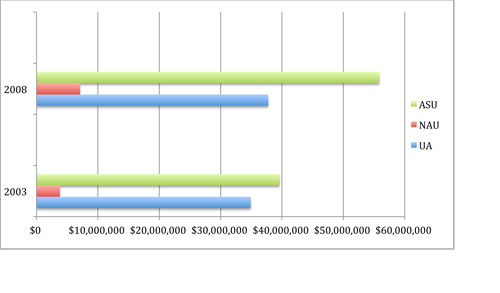{youtube width=”650″}5zbV1-4s7dQ{/youtube}
Sebastian Ionescu got lost on his first day of college at the University of Arizona.
Ionescu took 3-hours to journey back home instead of the normal 20-minutes. Perhaps he could have asked for directions, but Ionescu was still making his unfamiliar transition not only as a freshman but also as an international student from Braila, Romania.
“I was overwhelmed and scared,” Ionescu said. “I was not so confident with the language.”
Ionescu is a part of a rising trend of international enrollment that has brought more tuition dollars to the three Arizona universities. The increase in international admissions is also contributing to campus culture diversity that presents learning experiences for both American students and international students.
Increase in International Student Tuition Revenue over Five-Year period.

“International and out of state students do bring in more money, it’s about 2 ½ times the money per year in tuition cost over the Arizona resident students,” said Weston Brown, the international recruitment specialist in the office of admissions at the University of Arizona. “Where international students really shine over out-of-state students is that they are not eligible for financial aid, so it’s a straight cash revenue stream for us.”
With state government financial assistance for higher education decreasing during the economic downturn, Arizona’s three universities have turn to other ways to bring in funding.
“We want to keep out of state and international admissions up a little bit because they bring in lots of funding to the university,” Brown said. “But, we also have that obligation to serve Arizona tax payers as a state.”
According to Brown, the universities maintain balanced admissions to subsidize a cheaper education for in-state students and to emphasize staying in Arizona to return revenue to the state. Out of state or international students are bringing a quick dollar for a few years, but may go back home and never return—a result that doesn’t invest in Arizona’s future.
Additionally, professors must also manage the challenges of how to specifically evaluate and grade their international students. Brown says it takes a balance of realizing that if the international students aren’t native English speakers, their English will still be at an improving stage. However, professors still expect to find some demonstration of conceptual grasp and comprehension.
“The evaluation process isn’t really that different from a domestic evaluation. We look at the core courses that make up a GPA and other extracurricular activities,” Brown said. “They have to take a TOEFL test (test of English as a foreign language). Based on that score, we can grant admissions. Some professors and students have difficulties understanding each other, but I think that will happen when you have an international presence.”
The recent increasing trend of the international student population and its superior tuition dollars raises questions within the Arizona households of a prospective college students’ chances of admission into any one of the three universities.
However, according to Ryan Burton-Romero, associate director at the UA office of admissions, the Arizona Board of Regents imposed a standard where all three universities have the same admissions requirements for in-state applicants that is unaffected by international and out of state enrollment.
For an in-state student to be guaranteed admissions into any of the three universities, he or she must have no deficiencies, taken all 16-core courses, be in the top 25-percent of a high school graduating class and have attended an accredited high school.
The Board of Regents standard also allows for the three universities to accept up to 40-percent of an incoming freshman class as non-residents, including both international and out of state students.
Obviously, after being admitted to college as a freshman, a learning curve presents itself especially to international students trying to not only make the college transition, but also the international transition.
“I’ve been to America before, but just to visit,” said Sumeet Shinde, an international freshman from Pune, India. “It’s a lot different living here and getting used to a different way of living.”
The increasing international presence is also beneficial for American students, emphasizing diversity and a broader worldview, Burton-Romero says.
“It’s neat to see all these international students on campus and hear about their stories,” Burton-Romero said. “It broadens you and helps you to see the world in a different way. All students are learning about traditions and getting that social growth, professional growth and global exposure.”
Though campus culture is diversifying and continues to add a global presence, international students going to college abroad for four or more years are goal-oriented.
According to the UA admissions office, international students tend to focus on specific school rankings for their chosen majors of study as opposed to an all-inclusive decision-making process to attend a university in Arizona that takes into account student life, clubs, campus or athletics.
“A lot of international students are interested in our Eller College of Management and our engineering major,” Brown said. “It’s the top ranked programs that are the most popular. They’re not really caring much about student life. Those aren’t so important to goal-oriented students.”
Regardless of their reasons to attend Northern Arizona University, Arizona State University and UA, the international student population continues to trend upward. Current and potential American college students are gaining exposure to an international perspective that is currently represented by 117 countries at the UA.
“First semester, I was a little overwhelmed because I was lost,” Ionescu said. “Now, I’m very comfortable with everything; the campus, the people, my classes, the professors and talking with everyone.”









